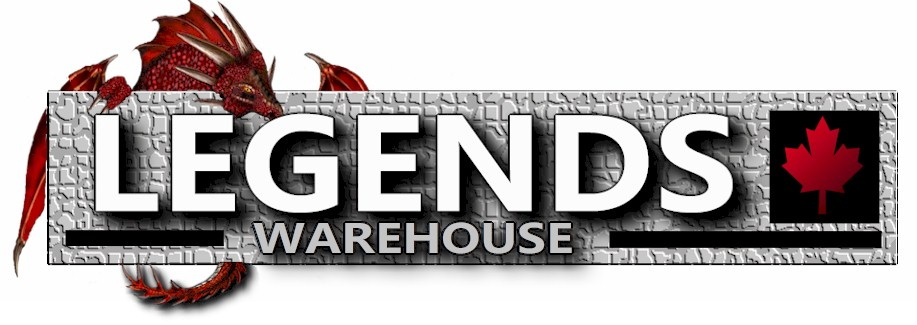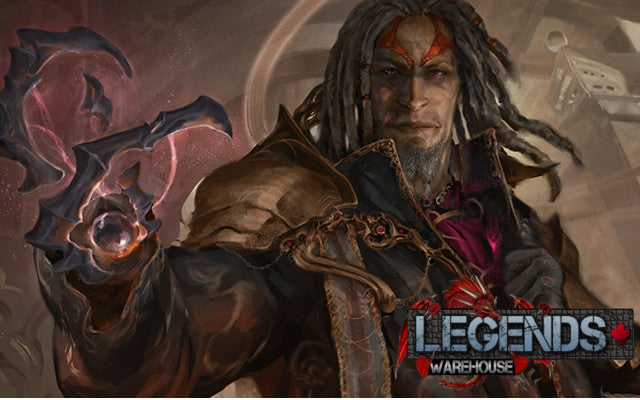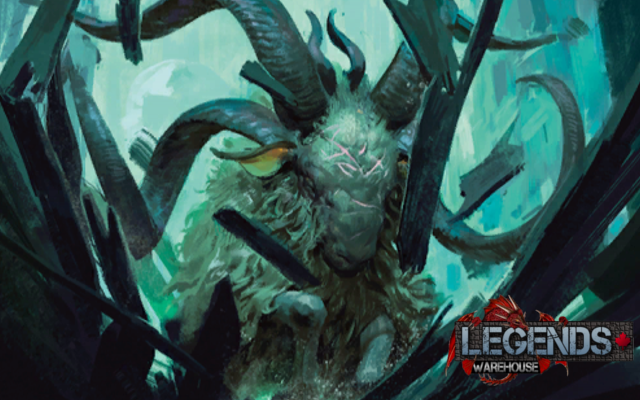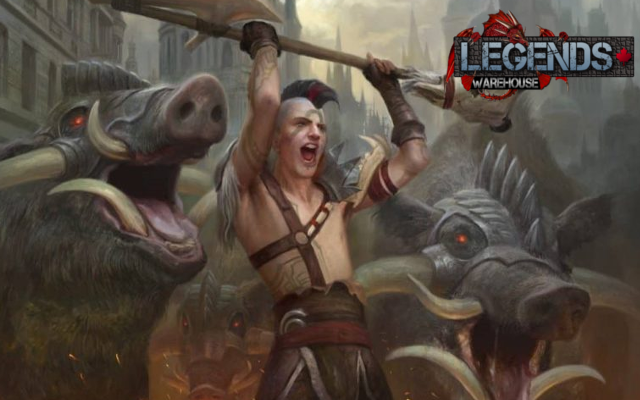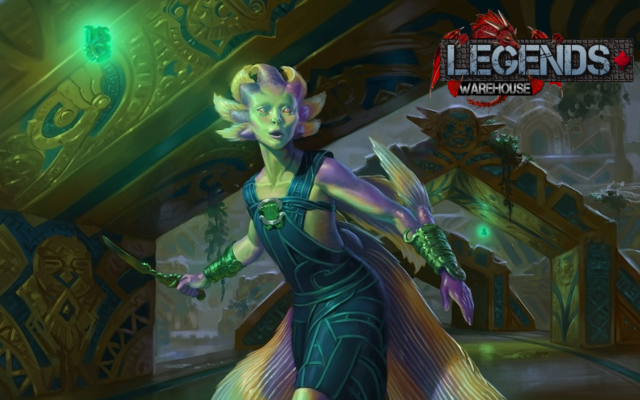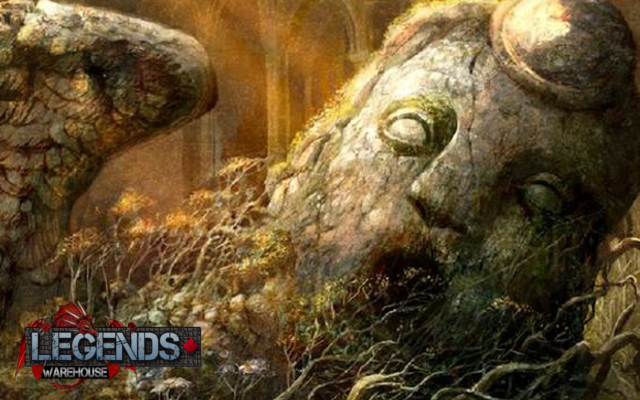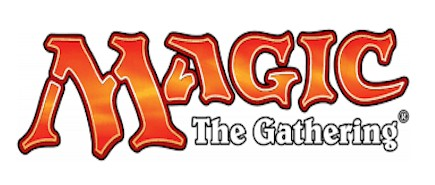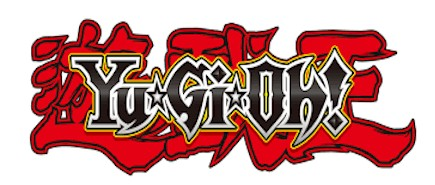A Night at the Improv
- Legends Warehouse News
- 03 Oct, 2017
Mechanics that lower the cost on spells are dangerous. Historically, whenever there has been a way to cheat on mana costs, they have proven to be exceptionally powerful. Affinity, Cascade, and Eye of Ugin have each been so dominant and oppressive that they caused several bannings in their respective formats. Aether Revolt introduced another such mechanic, Improvise, though that was met with far less enthusiasm given how broken Standard was at the time. It just got swept under the rug as Aetherworks Marvel and Felidar Guardian took over the format. Now that Standard has shed four sets of extra weight, Improvise is having its moment in the sun with a flexible and powerful control deck.
GRIXIS IMPROVISE 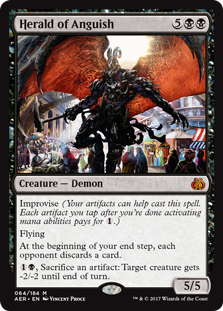
- 3 Tezzeret the Schemer
- 3 Contraband Kingpin
- 4 Herald of Anguish
- 4 Maverick Thopterist
- 2 Pia Nalaar
- 1 The Scarab God
- 1 Aethersphere Harvester
- 3 Cogworker’s Puzzleknot
- 4 Prophetic Prism
- 1 Servo Schematic
- 1 Sorcerous Spyglass
- 4 Fatal Push
- 4 Metallic Rebuke
- 1 Island
- 1 Mountain
- 3 Swamp
- 1 Dragonskull Summit
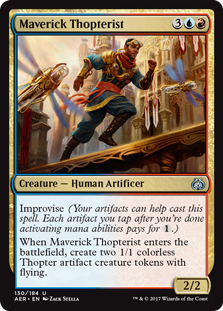
- 3 Drowned Catacomb
- 3 Fetid Pools
- 4 Spire of Industry
- 4 Spirebluff Canal
- 1 Inventor’s Fair
- 1 Aethersphere Harvester
- 1 Sorcerous Spyglass
- 3 Scrapheap Scrounger
- 3 Tezzeret’s Touch
- 4 Negate
- 3 Battle at the Bridge
This list took Zac Elsik to a first place finish at the SCG Classic in Dallas over the weekend, and it’s easy to see why. Through a combination of cheap, efficient artifacts in the early game, he is able to power out massive threats like Herald of Anguish much faster than most opponents are ready to deal with. The deck supports that powerhouse with bombs like Tezzeret the Schemer, which not only makes more artifacts to improvise with, but can also act as removal or even a win condition in his own right by animating artifacts every turn with his ultimate. As well, this is the best deck to take advantage of Metallic Rebuke, one of the strongest build-around-me counterspells in recent memory. Metallic Rebuke is an incredible tempo card, and because it has improvise itself, as long as you have one Blue mana and two artifacts untapped it becomes a nightmare to play against for fear of getting blown out.

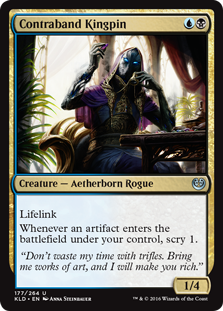

While the first weekend after a rotation is typically dominated by mainstays of the previous Standard, this deck performed well due to its ability to utterly crush aggressive decks like Ramunap Red. Contraband Kingpin is a great card in most matchups since it lets you scry whenever an artifact enters the battlefield, but the fact that it’s also a 1/4 lifelinker lets it stack up well against the majority of the threats in the aggro decks. The deck also has several ways of going wide to protect its life total. Pia Nalaar, Cogworker’s Puzzleknot, Servo Schematic, and Maverick Thopterist each come with 1/1 tokens, providing multiple bodies with which to block and trade with aggressive threats, so you end up trading your tokens for their actual cards. Since Ramunap Red isn’t exactly known for its card advantage, this goes a long way to keeping the match in your favour. The final nail in the coffin in the maindeck is Aethersphere Harvester, which is not only a sizable body for them to have to swing through, you can also give it lifelink to further negate their damage output. All in all this makes the deck a nightmare for one of the most established archetypes of the previous rotation.
The last card that makes this deck so spicy is The Scarab God, which these days is something of a necessity for anyone not playing Ramunap Red or Approach of the Second Sun. While not the core focus of the deck, here The Scarab God can turn your smaller improvise creatures into juggernauts at instant-speed. Maverick Thopterist is already strong when it’s improvised down to two mana, but can you imagine bringing a 4/4 and two 1/1 fliers to your field after the opponent has declared attacks? Or a 4/4 Contraband Kingpin against an aggro deck? Suddenly those little roadblocks you kept throwing down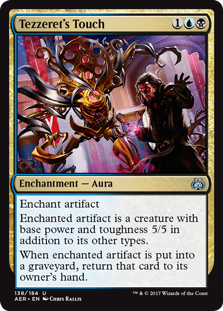 turn into massive threats on their own. While I wouldn’t go more than one or two copies, it feels like every time The Scarab God comes down it’s going to be game over very soon.
turn into massive threats on their own. While I wouldn’t go more than one or two copies, it feels like every time The Scarab God comes down it’s going to be game over very soon.
The sideboard is set up in such a way that it can handle control and midrange decks to make up for the maindeck being skewed toward aggressive decks. Scrapheap Scrounger and Tezzeret’s Touch give the deck some much needed early aggro to get in under control decks. Tezzeret’s Touch is particularly potent since it allows you to recur any of the artifacts with enter the battlefield abilities you may enchant. As well, curving a token-making artifact like Servo Schematic into Tezzeret’s Touch gives you six power on turn 3, which can easily catch opponents off guard.
A full set of Negate and extra copies of Sorcerous Spyglass are also quite strong against control decks since they give you more options to pressure them. Negate is one of the cheapest and cleanest answers to planeswalkers and board wipes like Fumigate, so a full set over running situational counters like Spell Pierce makes sense. Negate also acts as a tempo card when the deck starts to go aggressive since the opponent will often have to tap out for an early sweeper that we can counter with ease. When coupled with Metallic Rebuke this creates an absolutely brutal situation for slower decks. Sorcerous Spyglass comes in as an additional means of fighting planeswalkers, vehicles, and transform lands, as well as being a cheap artifact to improvise with. This also lets you look at their hand, so you have much better information as to what you’re playing against and what you’re going to have to worry about later on down the line.
While the maindeck is already capable of fending off aggro, the sideboard also includes an additional copy of Aethersphere Harvester as well as three copies of Battle at the Bridge. Having an additional copy of Aethersphere Harvester can quickly close out games against Ramunap Red or any other aggro deck since you’re gaining six life a turn, and even when you’ve run out of energy you still have a 3/5 with flying that can be tapped to improvise, so it’s still a fine card later on. Battle at the Bridge is a powerful removal spell against aggro and midrange decks that gets stronger the more we improvise. Furthermore, this also gives you permanent outs against indestructible threats like Hazoret the Fervent while gaining a ton of life. What makes this even crazier against aggro decks is that we can overpay for X to gain even more life. For example, if our opponent has an Ahn-Crop Crasher, we can jam our mana and artifacts into Battle at the Bridge and cast it for X = 8 and still gain eight life despite the Crasher only having two toughness. This does an amazing job of helping us stabilize in the mid to late game when they’re starting to run out of gas.
Having an additional copy of Aethersphere Harvester can quickly close out games against Ramunap Red or any other aggro deck since you’re gaining six life a turn, and even when you’ve run out of energy you still have a 3/5 with flying that can be tapped to improvise, so it’s still a fine card later on. Battle at the Bridge is a powerful removal spell against aggro and midrange decks that gets stronger the more we improvise. Furthermore, this also gives you permanent outs against indestructible threats like Hazoret the Fervent while gaining a ton of life. What makes this even crazier against aggro decks is that we can overpay for X to gain even more life. For example, if our opponent has an Ahn-Crop Crasher, we can jam our mana and artifacts into Battle at the Bridge and cast it for X = 8 and still gain eight life despite the Crasher only having two toughness. This does an amazing job of helping us stabilize in the mid to late game when they’re starting to run out of gas.
I have no doubt that Grixis Improvise will continue to be a staple of the Ixalan Standard metagame. There are plenty of tools to handle aggro, midrange, and control, and by cheating out monstrous threats like Herald of Anguish by turn 4 it can easily swing the course of a game. Going forward, I wouldn’t be surprised if it ran additional copies of The Scarab God or even a single Nicol Bolas, God-Pharaoh to further cement the long-game dominance if control and midrange start becoming more of the norm. If the meta skews even more toward aggro, I see this list only becoming better positioned, so if you’re looking to pick apart your opponents in the early stages of Standard, look no further than Grixis Improvise!

